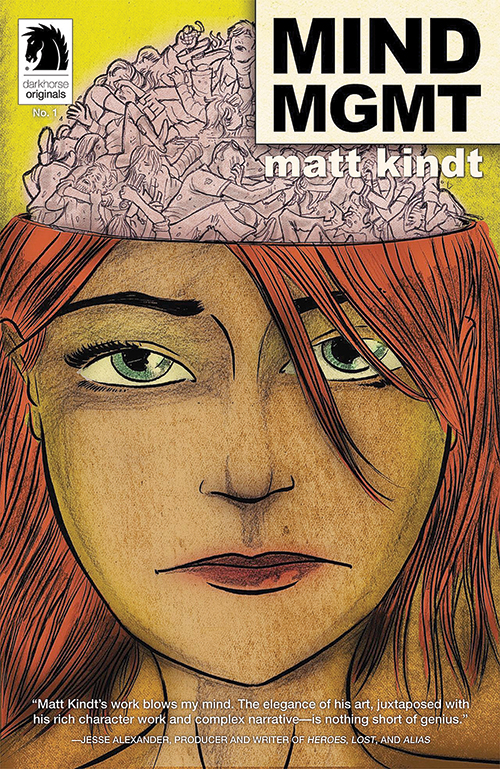From the Masons to the Knights Templar, conspiracy theories about secret societies and shadow governments have existed for hundreds of years. The idea that a powerful cabal of unknowns is manipulating the world at large is at once fascinating and terrifying, alluring and oppressive.
Head games

From the Masons to the Knights Templar, conspiracy theories about secret societies and shadow governments have existed for hundreds of years. The idea that a powerful cabal of unknowns is manipulating the world at large is at once fascinating and terrifying, alluring and oppressive.
Popular culture has capitalized on this paranoia with blockbuster movies like Men in Black. In the same vein—though on an entirely different appendage—comes Mind MGMT, a new graphic novel from Portland’s Dark Horse comics.
Cartoonist Matt Kindt takes on story and art duties, lending a singular voice to a labyrinthine plot that starts out simply enough.
The high concept: A formerly best-selling true crime writer named Meru seeks to regain her glory by getting to the root of the famous Amnesia Flight 815, during which 120 passengers and crew simultaneously lost their memories.
It sounds more than a little bit like the TV show Lost, and, sure enough, co-creator and showrunner Damon Lindelof wrote the introduction.
That’s about where the similarities end. Though Mind MGMT preserves the spirit of the serial mystery by drip-feeding answers while piling on more questions, the focus quickly shifts from the missing memories to the titular secret organization.
As Meru discovers, Mind MGMT once acted as a kind of syndicate for those with psychic abilities. One of them was behind the memory wipe on Amnesia Flight 815, but Mind MGMT agents come in all sorts of extrasensory flavors: Some write mind-controlling advertisements for print and television, some are adept at prediction to the point of clairvoyance and some can even stave off death by controlling the cells in their body.
Meru believes that she can uncover the truth by finding former Mind MGMT agent Henry Lyme (a nod to the enigmatic underworld figure Harry Lime, famously played by Orson Welles in the classic film version of The Third Man).
It’s not much of a spoiler to say that she does eventually track him down, but the real surprises come when Meru discovers her own connections to Mind MGMT.
Though conspiracy plots can sometimes flounder when the stories write themselves into a corner, Kindt tells the story with confidence: We get the feeling that he knows exactly where this is going.
When the bizarre and violent opening is revisited chapters later, everything clicks into place and a spontaneous free-for-all massacre somehow makes sense.
Kindt is dedicated to fleshing out this world with rules and interesting characters. The many side stories (some only available in single-issue format, and not in this hardcover) expand the mythos and serve to give the main story surer footing.
Even the presentation is committed to the Mind MGMT conceit. Almost every single illustrated page has been drawn on a Mind MGMT field report form, complete with blue lines and instructions to keep all pertinent information “inside this box.”
On the left side of most of these “forms” is a unique blurb from the Mind MGMT field guide.
Some describe methods and means of the organization (“If you find that you are short of funds in the field, remember that any paper can be mind augmented to perform in the place of real money”), while others seem to give clear hints to the subtext of the immediate story (“As a rule of thumb, if you cannot psychically determine whether a situation is a trap…it IS a trap”).
Though these extra kernels of info are not vital to the story, they are an awful lot of
fun to keep up with. Readers who pay attention to them throughout the book will notice an exceptionally interesting wrinkle toward the end.
The art painted on these field guide forms will likely be divisive: Kindt uses watercolor over rough, sketchy ink, which can get abstract or even crude at times.
Some will fawn over the dreamlike representation of a world where everything is vague and nothing is for certain, and others will say that their kid could do that. Many will vacillate between both sides.
Mind MGMT spends a lot of time filling out its world and crafting a mythology for the titular organization, to the point that the characterization sometimes suffers.
Meru and Henry Lyme are both interesting characters struggling with their own inner demons, but everyone else in the story is essentially a paper-thin plot device. Kindt gets away with this for the initial story arc, but any further adventures would do well to have a few more fleshed-out characters.
The first of presumably several volumes, Mind MGMT has a nice hook but really impresses with its follow-through.
Hopefully Kindt can keep up this momentum and deliver a satisfying conclusion to make a complete story—fingers crossed that there won’t be any Lost-esque frozen donkey wheels.





